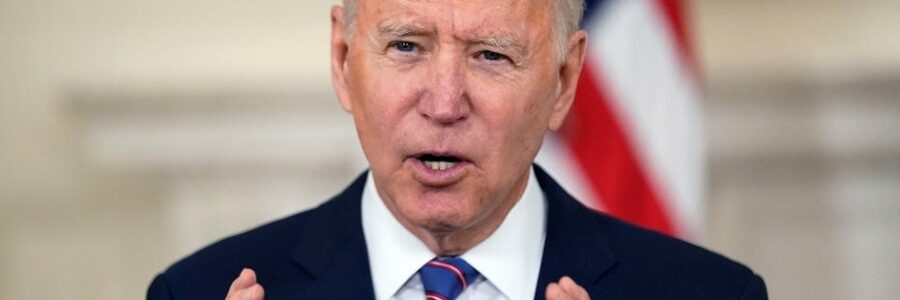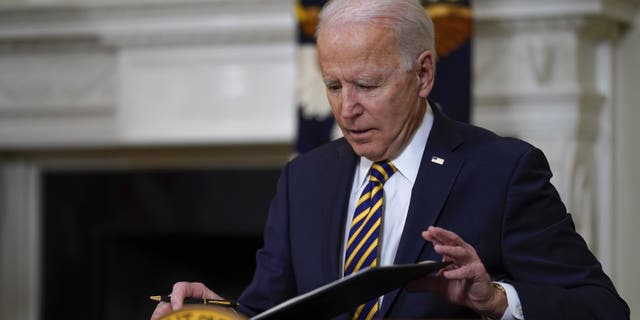
Biden keeps saying ‘follow the science,’ but how often does he?
Biden announces US-South Korea vaccine manufacturing partnership
President Biden and South Korean President Moon Jae-in delivered remarks Friday from the White House
“Follow the science.”
It’s a line President Biden used on the 2020 presidential campaign trail and has returned to many times, including in nationally televised remarks after taking office and in March to staffers at the Centers for Disease Control and Prevention, particularly when addressing the coronavirus pandemic or climate change.
Once elected, Biden announced that he would add the country’s first Cabinet-level science adviser. But grumblings over the mantra began even before he took office.
“After winning the election on a ‘listen to the scientists’ message, Joe Biden is actually rejecting the global scientific consensus on how to handle the pandemic,” writer Branko Marcetic wrote in a December essay for Jacobin, a socialist magazine, arguing in favor of a national lockdown order.
“There are already worrying signs that the incoming administration’s pandemic response is going to rely on science in the same way the Democrats rely on science when it comes to climate change: as a useful bit of branding to set them apart from their opposition, but something to be largely ignored if they feel the solution is too politically unpalatable,” he warned.
FILE – In this Feb. 24, 2021, file photo President Joe Biden closes the folder after signing an executive order relating to U.S. supply chains, in the State Dining Room of the White House in Washington. (AP Photo/Evan Vucci, File)
The president followed the science when the CDC updated its mask-wearing guidance last week – prompting critics to complain that he followed the science too abruptly.
“This guidance may be quite appropriate as individual guidance, but it is not appropriate as guidance for community action,” Tom Frieden, the Obama-era CDC director, told the Washington Post Thursday. “There was no urgency to change the mask guidance. That should have been done in a more planful way.”
On Inauguration Day, Biden announced the suspension of the Keystone XL pipeline, which was planned to carry 800,000 barrels of oil a day from Alberta, in Canada, to the Gulf Coast of Texas, by way of Montana, South Dakota, Nebraska, Kansas and Oklahoma. (Not to mention, the move infuriated Canadian officials.)
“The Federal Government must be guided by the best science and be protected by processes that ensure the integrity of Federal decision-making,” Biden said at the time. “It is, therefore, the policy of my Administration to listen to the science.”
Marty Durbin, president of the U.S. Chamber of Commerce’s Global Energy Institute, disagreed at the time, declaring in a statement that the move had nothing to do with science and would cost the U.S. thousands of jobs.
“The pipeline — the most studied infrastructure project in American history — is already under construction and has cleared countless legal and environmental hurdles,” he said. “Halting construction will also impede the safe and efficient transport of oil, and unfairly single out production from one of our closest and most important allies.”
Fast forward to this week, Biden waived sanctions on Russia’s Nord Stream 2 pipeline — a move Sen. Rob Portman, R-Ohio, bashed as a favor to the Kremlin that would hurt America’s European allies.
“By canceling the Keystone Pipeline only to give Putin a multibillion-dollar gift by waving mandatory U.S. sanctions to allow Russia to build Nord Stream 2, it makes you wonder, why does Joe Biden think pipelines and jobs in America are bad while pipelines and jobs in Russia are good?” Texas Republican Sen. Ted Cruz said Saturday evening.
Biden’s also faced criticism on the issue of school reopenings, and whether the administration has adhered to its “follow the science” mantra over the past three months.
CDC Director Rochelle Walensky told reporters in February that the vaccine was not a requirement for getting teachers back in the classroom.
“There is increasing data to suggest that schools can safely reopen and that safe reopening does not suggest that teachers need to be vaccinated,” Walensky said during a news briefing. “Vaccination of teachers is not a prerequisite for the safe reopening of schools.”
Yet the administration scaled back its goal of reopening schools within Biden’s first 100 days in office.
The goal became “the majority of schools – so more than 50%,” as White House Press Secretary Jen Psaki put it at the time, according to Politico.
She also defined “open” as hosting at least one day of in-person learning.
As of May 16, only 68.6% of American students attend district that offers a return to a traditional classroom setting, according to Burbio, a data aggregating site. And that doesn’t mean all of them have necessarily done so yet.
School reopening plans are still an issue – one House Republican Leader Kevin McCarthy called “Biden’s biggest failure so far” after leaked emails showed the CDC had corresponded with the nation’s largest teachers’ union as it hashed out the reopening guidance it released in February.
The union discouraged the administration from the full reopening plan and even influenced some of the wording in the CDC’s Feb. 12 announcement of its guidelines, according to a bombshell New York Post report on the emails.
“How many kids were kept from school because the Biden administration allowed the ‘science’ to be manipulated by special interest groups?” McCarthy wrote in a May 6 blog post. “How many parents were forced to pass up on income for their families because the CDC failed to follow the science?”
He added, “It is well past time we follow the science and reopen the schools.”
Science is often evolving as new data emerges, and following it strictly may require an about-face – resulting in political pressure on the president. Then he has the choice of staying the course on his policy goals or adapting them based on new data to “follow the science.”
The White House did not immediately respond to Fox News’ requests for comment.
Fox News’ Caitlin McFall and the Associated Press contributed to this report.
Source: Read Full Article

